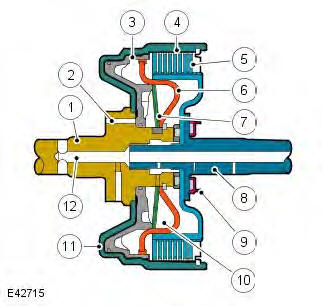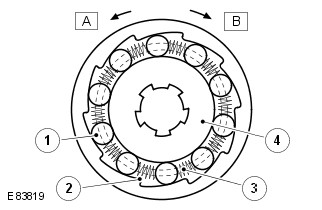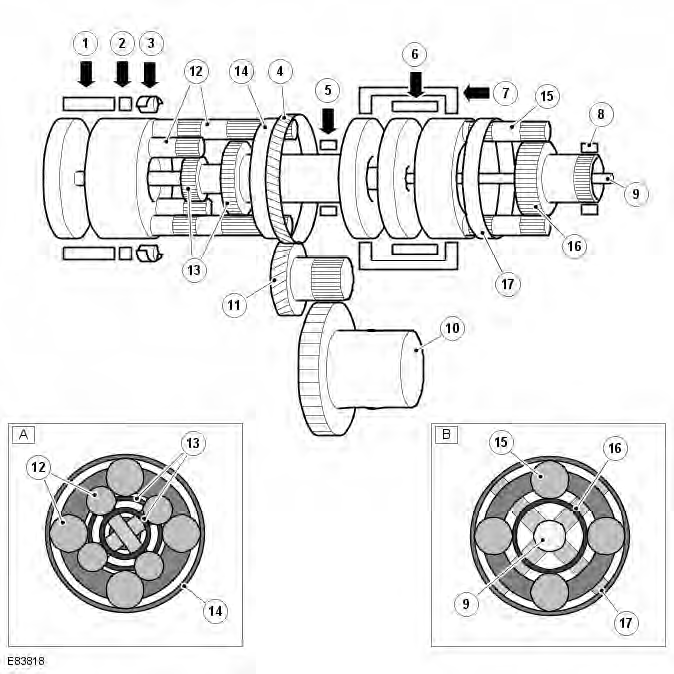Range Rover Evoque: Drive Clutches, Planetary Gear Train
DRIVE CLUTCHES
Multiplate Drive or Brake Clutch - Typical

- Input shaft
- Main pressure supply port
- Piston
- Cylinder - External plate carrier
- Clutch plate assembly
- Baffle plate
- Diaphragm spring
- Output shaft
- Bearing
- Dynamic pressure equalisation chamber
- Piston chamber
- Lubrication channel
There are three drive clutches and two brake clutches (B2 is a multiplate brake clutch & B1 is a double wrap brake band) used in the AW F21 transmission. Each clutch comprises one or more friction plates dependent on the output controlled. A typical clutch consists of a number of steel outer plates and inner plates with friction material bonded to each face.

The clutch plates are held apart mechanically by a diaphragm spring and hydraulically by dynamic pressure. The pressure is derived from a lubrication channel which supplies fluid to the bearings etc. The fluid is passed via a drilling in the output shaft into the chamber between the baffle plate and the piston. To prevent inadvertent clutch application due to pressure build up produced by centrifugal force, the fluid in the dynamic pressure equalization chamber overcomes any pressure in the piston chamber and holds the piston off the clutch plate assembly.
When clutch application is required, main pressure from the fluid pump is applied to the piston chamber from the supply port. This main pressure overcomes the low pressure fluid present in the dynamic pressure equalization chamber. The piston moves, against the pressure applied by the diaphragm spring, and compresses the clutch plate assembly. When the main pressure falls, the diaphragm spring pushes the piston away from the clutch plate assembly, disengaging the clutch.
One-Way Clutch

- Roller
- age
- Spring
- Inner race
The roller clutch used on the one-way clutch uses parallel rollers, located between the smooth, cylindrical inner race and the inclined cam faces of the clutch body. Springs are used to hold the rollers in position between the two contact faces.
When the clutch is rotated in a clockwise direction, the rollers become trapped between the inner race and the inclined cam faces of the clutch body, providing positive (locked) rotation of the inner race, locking the counter-clockwise rotation of the rear planetary carrier. When the clutch is rotated in a clockwise direction, the rollers are moved away from the inclined cam faces and can rotate freely (unlocked) with the clutch body, providing no drive from the clutch to the rear planetary carrier. In this condition the clutch can rotate freely on the inner race.
PLANETARY GEAR TRAIN

- Double web planetary gear train - Rear
- Single web planetary gear train - Front
- Clutch C2
- Brake B2
- Free wheel clutch F2
- Counter drive gear
- Brake B1
- Clutch C1
- Clutch C3
- Fluid pump
- Input shaft
- Differential gear assembly
- Counter gear assembly
- Pinion gears
- Sun gears
- Ring gear
- Pinion gear
- Sun gears
- Ring gear
The planetary gear trains used on the AW F21 transmission comprise a single web planetary gear train and a double web planetary gear train. These gear trains are known as Ravignaux type gear trains and together produce the six forward gears and the one reverse gear.
Engine torque is transferred, via operation of single or combinations of clutches to the two planetary gear trains. Both gear trains are controlled by reactionary inputs from brake clutches to produce the six forward gears and one reverse gear. The ratios are as follows:


